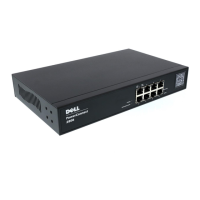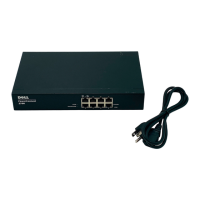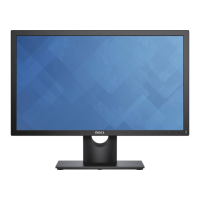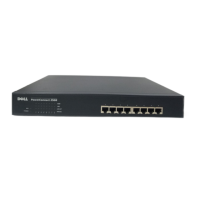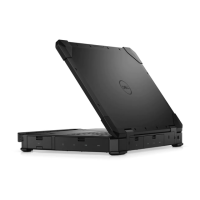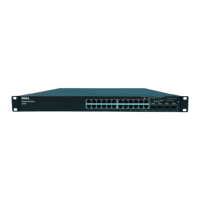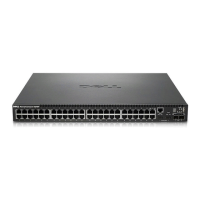Do you have a question about the Dell PowerConnect 2816 and is the answer not in the manual?
Describes the hardware configurations of the PowerConnect 28xx switches.
Details the front panel and ports of the PowerConnect 2808.
Details the front panel and ports of the PowerConnect 2816.
Details the front panel and ports of the PowerConnect 2824.
Details the front panel and ports of the PowerConnect 2848.
Provides a summary table of all PowerConnect models.
Covers management modes, HOL blocking prevention, and back pressure support.
Explains auto-negotiation, jumbo frames, MDI/MDIX, flow control, and virtual cable testing.
Discusses MAC address support, Green Ethernet, IGMP Snooping, Port Mirroring, Storm Control, DVA.
Explains VLANs, link aggregation, DHCP server functionality.
Covers Spanning Tree Protocol, DHCP Server, Class of Service, and Management Features.
Covers web-based management, TFTP, and RMON.
Describes front and back panel port configurations for the 28xx series.
Lists the physical dimensions for the 2808, 2816, 2824, and 2848 models.
Explains the status indications for Power, Managed Mode, Fan, and Port LEDs.
Covers cable requirements, RJ-45 and SFP port details, and pin assignments.
Lists crucial safety and environmental considerations before installation.
Details the necessary environmental and power conditions for installation.
Covers checking package contents and the procedure for safely unpacking the device.
Explains the three methods for physically installing the switch: in a rack, on a flat surface, or on a wall.
Describes how to connect the device to the network, a terminal, and a power supply.
Describes the steps and observations for booting the switch in managed mode.
Guides through the setup wizard for initial device configuration.
Covers dynamic IP address allocation using DHCP.
Outlines startup menu options like software download, flash erase, and password recovery.
Details how the device acts as a DHCP client to obtain an IP address.
Introduces the user interface with Tree View and Device View.
Describes the graphical device representation and port LED indicators.
Details the function of Information and Device Management buttons.
Steps to launch and log into the Switch Administrator.
Explains the different access levels (Management, Monitor).
Configuring system name, location, contact, and asset details.
Displays the current software and hardware version information.
Procedures for remotely resetting the switch to its default state.
How to configure the switch for secure management mode, disabling IP access.
Assigning static IP addresses, subnet masks, gateways, and configuring DHCP.
Performing tests to diagnose issues with copper and fiber optic cables.
Configuring user accounts, passwords, and RADIUS security settings.
Securing the network using port-based authentication and advanced methods.
Setting up port parameters, Green Ethernet, Storm Control, and Port Mirroring.
Managing MAC address entries and their aging time.
Configuring global, port, and LAG settings for STP and Rapid STP.
Creating, managing, and assigning ports to VLANs and VLAN LAGs.
Combining ports into Link Aggregated Groups (LAGs) for increased bandwidth and redundancy.
Managing Multicast Forwarding, Bridge Multicast Groups, and IGMP Snooping.
Collecting and viewing network traffic statistics using RMON.
Displaying statistics in graphical chart format.
Monitoring the device's CPU usage.
Explains QoS classification based on packet fields and VLAN Priority Tags.
Details how to assign services to queues using Strict Priority or Weighted Round Robin.
Configuring overall Quality of Service settings and trust modes.
Applying QoS configurations to specific network interfaces.
Configuring the scheduling methods for traffic queues.
Associating Class of Service values with specific traffic forwarding queues.
Mapping Differentiated Services Code Point values to forwarding queues.
Explains how to connect using console or Telnet for command-line management.
Describes the different command modes: User EXEC, Privileged EXEC, Global Configuration, and Interface Configuration.
Details essential CLI commands for device management.
Describes the hardware configurations of the PowerConnect 28xx switches.
Details the front panel and ports of the PowerConnect 2808.
Details the front panel and ports of the PowerConnect 2816.
Details the front panel and ports of the PowerConnect 2824.
Details the front panel and ports of the PowerConnect 2848.
Provides a summary table of all PowerConnect models.
Covers management modes, HOL blocking prevention, and back pressure support.
Explains auto-negotiation, jumbo frames, MDI/MDIX, flow control, and virtual cable testing.
Discusses MAC address support, Green Ethernet, IGMP Snooping, Port Mirroring, Storm Control, DVA.
Explains VLANs, link aggregation, DHCP server functionality.
Covers Spanning Tree Protocol, DHCP Server, Class of Service, and Management Features.
Covers web-based management, TFTP, and RMON.
Describes front and back panel port configurations for the 28xx series.
Lists the physical dimensions for the 2808, 2816, 2824, and 2848 models.
Explains the status indications for Power, Managed Mode, Fan, and Port LEDs.
Covers cable requirements, RJ-45 and SFP port details, and pin assignments.
Lists crucial safety and environmental considerations before installation.
Details the necessary environmental and power conditions for installation.
Covers checking package contents and the procedure for safely unpacking the device.
Explains the three methods for physically installing the switch: in a rack, on a flat surface, or on a wall.
Describes how to connect the device to the network, a terminal, and a power supply.
Describes the steps and observations for booting the switch in managed mode.
Guides through the setup wizard for initial device configuration.
Covers dynamic IP address allocation using DHCP.
Outlines startup menu options like software download, flash erase, and password recovery.
Details how the device acts as a DHCP client to obtain an IP address.
Introduces the user interface with Tree View and Device View.
Describes the graphical device representation and port LED indicators.
Details the function of Information and Device Management buttons.
Steps to launch and log into the Switch Administrator.
Explains the different access levels (Management, Monitor).
Configuring system name, location, contact, and asset details.
Displays the current software and hardware version information.
Procedures for remotely resetting the switch to its default state.
How to configure the switch for secure management mode, disabling IP access.
Assigning static IP addresses, subnet masks, gateways, and configuring DHCP.
Performing tests to diagnose issues with copper and fiber optic cables.
Configuring user accounts, passwords, and RADIUS security settings.
Securing the network using port-based authentication and advanced methods.
Setting up port parameters, Green Ethernet, Storm Control, and Port Mirroring.
Managing MAC address entries and their aging time.
Configuring global, port, and LAG settings for STP and Rapid STP.
Creating, managing, and assigning ports to VLANs and VLAN LAGs.
Combining ports into Link Aggregated Groups (LAGs) for increased bandwidth and redundancy.
Managing Multicast Forwarding, Bridge Multicast Groups, and IGMP Snooping.
Collecting and viewing network traffic statistics using RMON.
Displaying statistics in graphical chart format.
Monitoring the device's CPU usage.
Explains QoS classification based on packet fields and VLAN Priority Tags.
Details how to assign services to queues using Strict Priority or Weighted Round Robin.
Configuring overall Quality of Service settings and trust modes.
Applying QoS configurations to specific network interfaces.
Configuring the scheduling methods for traffic queues.
Associating Class of Service values with specific traffic forwarding queues.
Mapping Differentiated Services Code Point values to forwarding queues.
Explains how to connect using console or Telnet for command-line management.
Describes the different command modes: User EXEC, Privileged EXEC, Global Configuration, and Interface Configuration.
Details essential CLI commands for device management.
| Ports | 16 x 10/100/1000BASE-T |
|---|---|
| Switching Capacity | 32 Gbps |
| Forwarding Rate | 23.8 Mpps |
| VLAN Support | Yes, up to 256 VLANs |
| Rack Mountable | Yes, 1U |
| Relative Humidity | 10% to 90% non-condensing |
| Management | Web-based, CLI |
| MAC Address Table Size | 8K MAC addresses |
| Operating Temperature | 0°C to 45°C (32°F to 113°F) |
| Storage Temperature | -20°C to 70°C |
| Jumbo Frame Support | Yes |
| Dimensions | 440 x 257 x 44 mm (17.3 x 10.1 x 1.7 in) |
